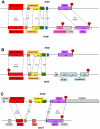Origin and evolution of TRIM proteins: new insights from the complete TRIM repertoire of zebrafish and pufferfish
- PMID: 21789205
- PMCID: PMC3137616
- DOI: 10.1371/journal.pone.0022022
Origin and evolution of TRIM proteins: new insights from the complete TRIM repertoire of zebrafish and pufferfish
Abstract
Tripartite motif proteins (TRIM) constitute a large family of proteins containing a RING-Bbox-Coiled Coil motif followed by different C-terminal domains. Involved in ubiquitination, TRIM proteins participate in many cellular processes including antiviral immunity. The TRIM family is ancient and has been greatly diversified in vertebrates and especially in fish. We analyzed the complete sets of trim genes of the large zebrafish genome and of the compact pufferfish genome. Both contain three large multigene subsets--adding the hsl5/trim35-like genes (hltr) to the ftr and the btr that we previously described--all containing a B30.2 domain that evolved under positive selection. These subsets are conserved among teleosts. By contrast, most human trim genes of the other classes have only one or two orthologues in fish. Loss or gain of C-terminal exons generated proteins with different domain organizations; either by the deletion of the ancestral domain or, remarkably, by the acquisition of a new C-terminal domain. Our survey of fish trim genes in fish identifies subsets with different evolutionary dynamics. trims encoding RBCC-B30.2 proteins show the same evolutionary trends in fish and tetrapods: they evolve fast, often under positive selection, and they duplicate to create multigenic families. We could identify new combinations of domains, which epitomize how new trim classes appear by domain insertion or exon shuffling. Notably, we found that a cyclophilin-A domain replaces the B30.2 domain of a zebrafish fintrim gene, as reported in the macaque and owl monkey antiretroviral TRIM5α. Finally, trim genes encoding RBCC-B30.2 proteins are preferentially located in the vicinity of MHC or MHC gene paralogues, which suggests that such trim genes may have been part of the ancestral MHC.
Conflict of interest statement
Figures








References
-
- Reddy BA, Etkin LD, Freemont PS. A novel zinc finger coiled-coil domain in a family of nuclear proteins. Trends Biochem Sci. 1992;17:344–345. - PubMed
-
- Short KM, Cox TC. Subclassification of the RBCC/TRIM superfamily reveals a novel motif necessary for microtubule binding. J Biol Chem. 2006;281:8970–8980. - PubMed
-
- Henry J, Mather IH, McDermott MF, Pontarotti P. B30.2-like domain proteins: update and new insights into a rapidly expanding family of proteins. Mol Biol Evol. 1998;15:1696–1705. - PubMed
Publication types
MeSH terms
Substances
LinkOut - more resources
Full Text Sources
Molecular Biology Databases
Research Materials

